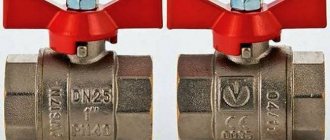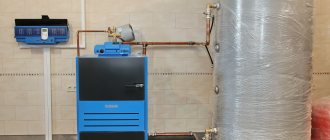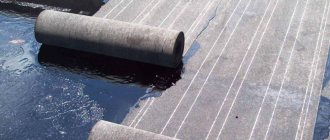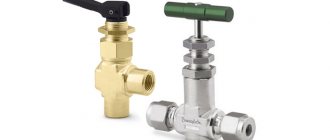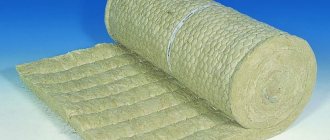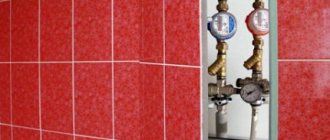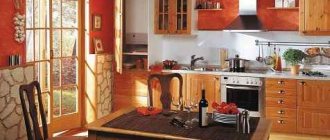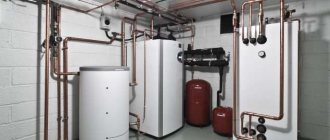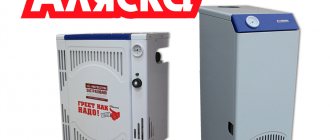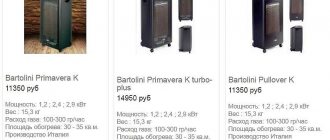Sewer trap is an indispensable element of plumbing equipment. It serves to prevent strong unpleasant odors from entering the room from the drainage system. What is the principle of operation of the device, what are the types of hydraulic valves, how to choose the right product and install it? All answers are contained in this article.
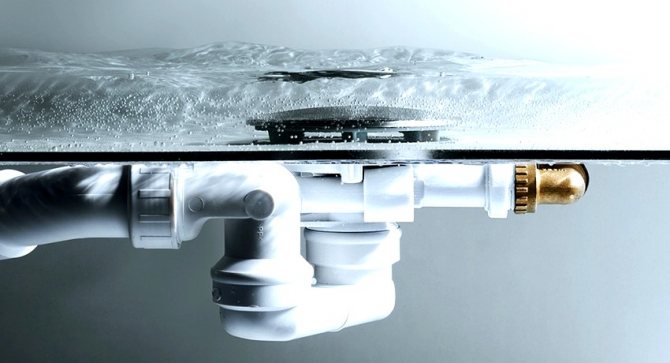
The sewer odor trap is used to prevent the penetration of unpleasant odors into the room from the drainage system
Water trap: this is a must-have element of plumbing equipment
The first step is to figure out what a shutter is. The element is represented by a pipe with bends, which has a certain shape. It can be additionally equipped with dynamic or dead-end devices. In the lower elbow of the siphon, there is a permanently located water plug, which, if the system is not used for a long time, can evaporate, which will lead to the penetration of unpleasant odors from the sewer network into the room.
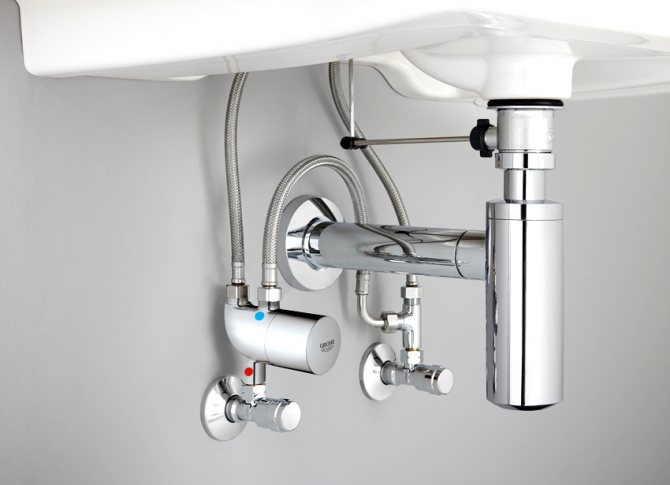

For the correct operation of the hydraulic seal, there must always be water in its cavity.
With the active operation of plumbing equipment, the fluid supply is constantly updated, successfully containing foul-smelling substances. When draining, wastewater flows freely through the siphon, which eliminates the likelihood of clogging the system.
Important! For the correct functioning of the hydraulic seal, a certain volume of water must be located in its cavity, which is necessary to prevent gas backflow and unpleasant odors.
What is a water seal for? The siphon blocks hydraulic shocks, which significantly reduces the load on sewer pipes and devices. It also protects living quarters from the penetration of unpleasant odors from the drainage system.
A water seal is rarely found inside a particular plumbing device, such as a toilet or urinal. Mostly it is mounted to the fixture. The residential building does not have a washbasin, bathtub, shower cubicle or toilet without a water seal.
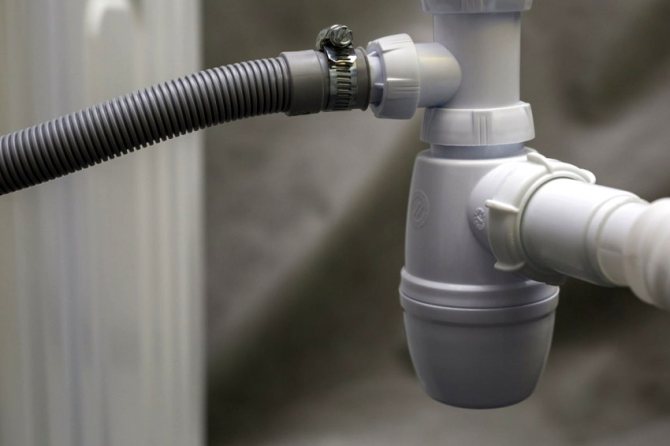

The hydraulic seal can be inside the plumbing device, but mostly it is mounted separately
Why do you need a water seal
In the moonshine business, home brew plays a very important role, on the success of which the final result will depend. The fermentation process is characterized by the yeast's conversion of sugar into ethyl alcohol and carbon dioxide. Carbon dioxide accumulates during fermentation, which can lead to an explosion of the container.
To prevent an accident, it is necessary to provide the carbon dioxide with a way out of the apparatus. But simply opening the fermentation tank will not work, since when air enters the container with the wash, the activity of bacteria that eat alcohol and produce vinegar is activated.
In order to avoid the transformation of wine or moonshine into it, the fermentation tank is equipped with a water seal, which is designed to release carbon dioxide and prevent air from entering the container.
Varieties of hydraulic valves, depending on the design
Depending on the design features, there are 6 types of hydraulic locks: elbow, bottle, double-turn, corrugated, dry and with an overflow system.
The elbow siphon with a water seal is easily recognizable by its appearance. Its design resembles the Latin letter U. The siphon is made of plastic or metal.The first option is presented by polypropylene products, which are characterized by reliability, simplicity and ease of installation. For the manufacture of metal siphons, cast iron or bronze is used. Today, such models are less common due to their high cost.
Plastic devices can be produced in a disposable design, they do not have the ability to adjust the position of the element. In case of failure, a complete dismantling of the product is carried out. Other models are made up of building blocks that can move and rotate to adjust the position of the nozzle. The parts are fixed by means of overhead plastic nuts and clamps.
The knee has two bends: inlet and outlet. The lower position of the second element is 5-6 cm below the first. More reliable and durable options are presented by the S-shaped design. Cleaning of the product is carried out using a special flexible cable with a brush at the end or by hand after disassembling the product.
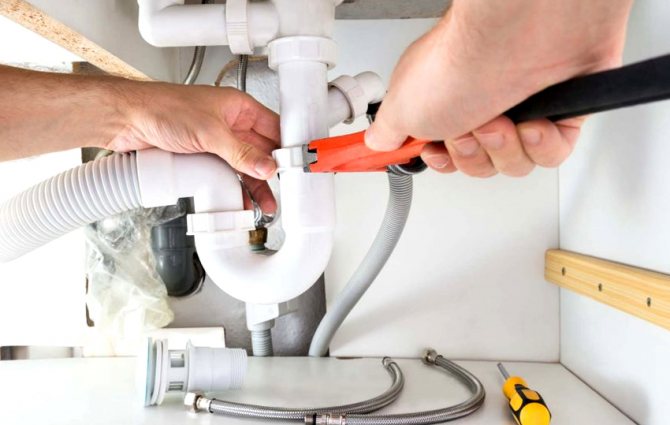

The elbowed water seal for the sewage system has a U- or S-shaped design
Such a water seal of the sewage system is characterized by its durability, which ensures a free and easy installation of the system without fear of damage to it. Elbow siphons are mainly installed on sinks, bathtubs and toilets. There are models equipped with an additional outlet, which makes it possible to simultaneously use a water seal for the washing machine.
Distinctive features of hydraulic bottle seals
Bottle fixtures are most often installed in kitchens under sinks. To understand how a water seal works, you should study its design. The product is designed in such a way that food waste particles are trapped, preventing clogging of the system in order to maintain its good performance. At the same time, such a shutter performs the main function, which is to retain unpleasant odors and eliminate the likelihood of them getting into the room.
The bottle odor trap consists of pipes and an additional bottle-shaped element, which is a kind of container for collecting food waste. This container is located below the level of the drain pipe, this provides free access to the element. The container includes a vertical drain pipe connected to the sink, from its side part there is a branch pipe for connection to the sewer network.
Bottle siphons are made of polypropylene, however, in terms of strength, they are inferior to knee counterparts. This is due to the fact that the connection of all elements may not withstand the strong pressure of water. However, the bottle siphon is most suitable for use in the kitchen. A positive point also lies in the lower price of a water seal for a 110 mm sewage system, which averages 250 rubles.
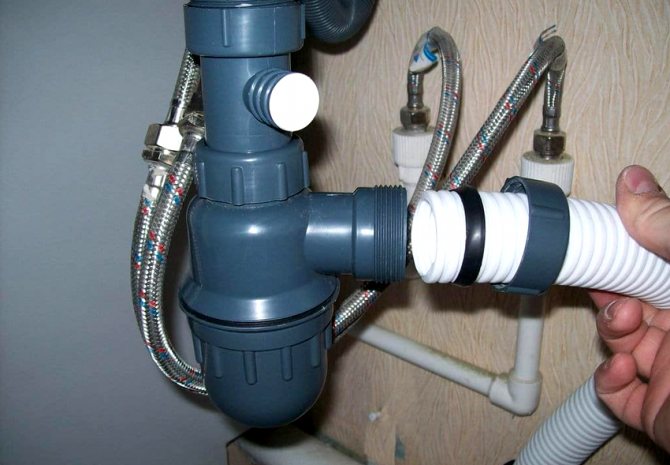

Due to its structure, the bottle odor trap is best suited for use in the kitchen
For normal operation of the device, it must be periodically cleaned, since the remains of food waste accumulate in the cavity of the container, preventing the free flow of drainage water. Remove the container to clean it. For this, the overhead nut is unscrewed, all the debris is shaken out of the container. Then you should thoroughly wash the inside of the container with detergents and hot water. After that, the device is installed in its original place. The nut is tightly tightened to prevent water leakage.
Important! Bottle odor traps are capable of trapping an object that accidentally falls into the drain.
Types of ready-made water traps
These devices can have different designs, as a rule, they are of two types:
- Collapsible.The device consists of two flasks inserted one into the other. The advantage of this design is its small size and ease of use.
- Two-chamber. In essence, these traps are curved tubes with chambers connected in series into which water should be poured. An elastic band is attached to one end of the tube, it acts as a seal. In this case, you need to monitor its condition, since over time it dries up, and replace it in time.
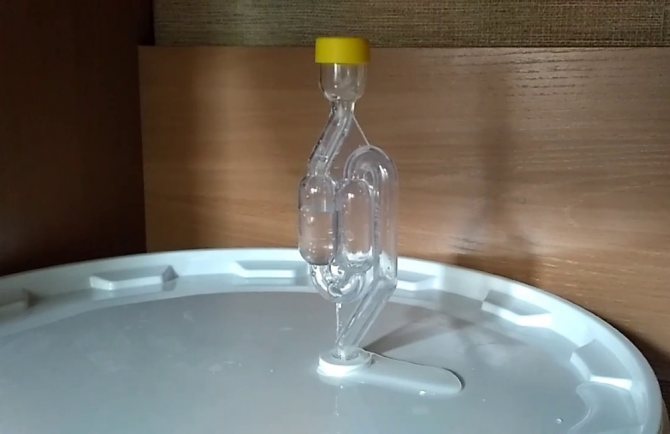

The odor trap can be purchased from your specialist retailer.
What is a double-turn bathroom odor trap
A two-turn siphon is an analogue of a knee outlet, but it differs in a more complex water seal device. The drain pipe of the device is connected to the outlet of the plumbing equipment. In this place, an additional filter grate is installed to trap hair and animal hair. It smoothly turns into an elbow, which connects to another pipe, which is directed to the drain. The last element is located at a slight incline.
How to use the odor trap when cleaning it? For this, some models of double-turn siphons can additionally be equipped with inspection holes, which are tightly closed with plugs, which makes it possible to inspect and clean the cavity of the hydraulic seal from contamination. They are at the bottom of the device. The hole function can be performed by a removable piece of the knee located in the upper part of the device.
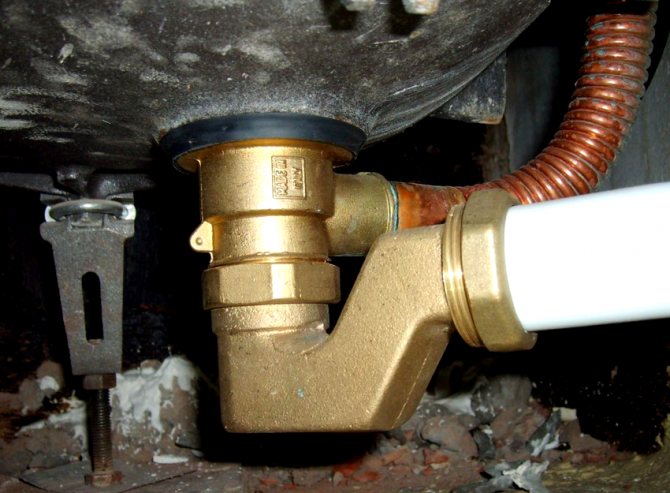

A two-turn odor trap for a bathroom is an analogue of a cranked one, but it is a more complex device.
Important! Double-turn valves are predominantly installed in bathrooms.
Double-turn siphons are made of polypropylene. More expensive models of the elite class can be made of brass with a chrome finish. When installing such products, you will need a special tool equipped with soft sponges, which will exclude the possibility of damaging the mirror surface of the device.
Bottle type hydraulic valves are characterized by strength, reliability and long-term operation. The structure is easily adjustable thanks to the movable components. It is easy to install and can be installed even in tight spaces.
Shutter types
Based on the design features of the device, there are 6 types of water locks:
- Knee type of water seal. Outwardly similar to the letter "U", a robust mechanism that can withstand the maximum level of pressure in the sewer pipes. The volume of the passed liquid depends on the inner circumference of the pipe, it must be greater than the release of plumbing fixtures. The knee is used for toilets and baths, it happens that not one, but two shutters are connected.
Reference! Previously, knee parts were made of bronze, cast iron, today they use cheap, lightweight, practical polypropylene material. The installation of the plastic device is very simple.
Siphons of this type are monolithic; during breakdowns, it is necessary to replace the entire structure. Some devices consist of parts that, if necessary, can be interchanged or with the help of them increase the length of the product in order to change the volume of fluid inside the structure. The location of the device requires fixing with nuts, plastic clamps. The knee type is equipped with kinks when entering and exiting the device. The kinks are at a slope of five degrees. A more reliable shutter is provided by an S-shaped device that works in the same way. Knee water locks require periodic cleaning inside the device: by dismantling the structure or using a flexible cable.Sometimes the design includes a branch for connecting a drain hose from washing machines, dishwashers.
- Bottle type water seal. The bottle-shaped closure is used in kitchen sinks. With the plates, food debris gets into the sewer system, which can clog the pipes. The water seal prevents large food waste from going further into the sewer and preserves the life of the pipeline. At the same time, it copes well with the main task - protecting the premises from biogas and stench from the sewage system.

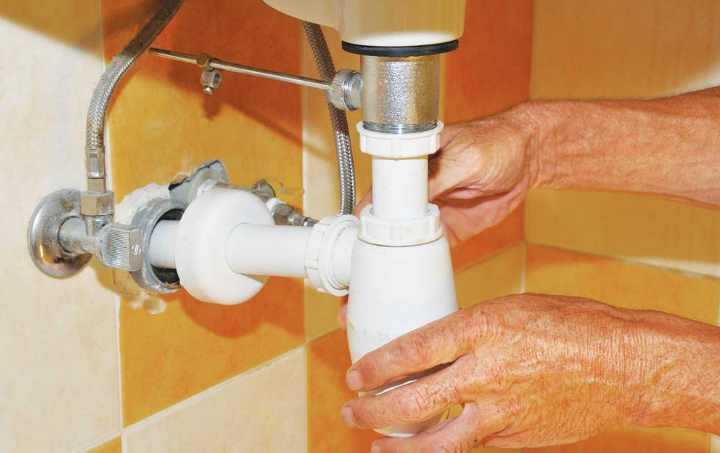
The structure consists of a pipe, a part in the form of a bottle, which collects debris entering the drain. The waste container is located at a level below the drain pipe, if necessary, it is easy to disassemble it. Reference! The parts of the bottle-type structure are connected in a specific way. The pipe is installed in a vertical position in an element that acts as a sump, which is located below. A branch is connected to the side, which is directed horizontally into the sewer. The odor trap is made of polypropylene material, although it is considered durable, but not as reliable as the knee type. The device is not designed for a strong pressure of liquid and is only suitable for sinks in the kitchen, not in a toilet with a bathtub.The odor trap must be cleaned when a blockage develops in the bottle element and water does not go down the drain. Blockages are easily removed thanks to the special shape of the shutter. To do this, unscrew the nut, with which the "bottom" of the bottle is attached, and remove the debris. The element is put in place and the nut is tightened as tight as possible so that there are no leaks.
Attention! Bottle devices have the useful property of retaining objects trapped in the flush, such as rings, which slide off when the dishes are washed.
- Double-breasted shutter type. The model has a complicated shape, in contrast to the knee, which it looks like. The pipe that drains the water, at the junction with the plumbing, is equipped with a special grate that serves as a filter for drains, trapping hair and various types of waste. The drain pipe forms an elbow that connects to the inclined pipe leading to the sewer. Reference! Sometimes double-breasted devices have an inspection hole for convenient cleaning of the pipe, it is tightly closed with a plug. Often, instead of a hole, a twisting knee element is installed. The hole is made at the lowest point of the device, and the removable element is located at the top. These siphons today are not made of cast iron, as before, but of polypropylene material. Cast iron valves of this type can be found in enterprises that drive a large volume of water under high pressure. Chrome-plated closures are not inferior in quality to parts made of polypropylene, they have a more noble look. Double-sided designs are easy to use and prevent leaks, unlike bottle seals. They have a design that lends itself to adjustment and can be installed in a confined space.
- Corrugated type odor trap. Hydraulic locks are flexible, reliable in design, indispensable in pipelines laid in small rooms. The corrugation is configurable and fits easily into tight spaces. Also, this element can be turned in the desired direction, given the required angle, in contrast to hard plastic, which is attached only using several methods. Attention! Devices with a corrugation are convenient for installation under the bathroom, where there is little space. The only, but weighty disadvantage of the device is considered to be a high level of tendency to contamination, which is facilitated by the specific walls of the gate in the form of ribs. Pieces of food, hair, soap, etc. easily remain in them. When installing a corrugated shutter, it is necessary to install a grate with a filter on the drain inlet.
Over time, dirt can cause the device to lose its elastic properties, become less durable, because cracks can form in the ribbed folds, allowing drains to pass through. If the sewage system is equipped with this type of siphon, it is worthwhile to clean the parts in a timely manner. Places with blockages form corrugation sagging.
- Water seal type with overflow pipe. Water traps equipped with an overflow system have an additional pipe. The overflow pipe will prevent flooding in the bathroom. With a full set of water in the sink, the liquid, reaching the mark with the overflow pipe, will go through it into the sewer pipe. Attention! For the overflow water seal, special sinks are used, equipped with a second hole in the sink bowl. Bath models have an overflow system, protecting against overflow over the edges of the tank. Overflow valves are made of metal and plastic. Metal devices are more expensive and difficult to install.
- Dry shutter type. The dry type of the shutter has a radically opposite design in contrast to the water ones. It is based on the principle of operation of the nipple. The device looks like a threaded pipe with a check valve installed inside. The incoming water has no outlet back, and with it the gases remain inside the pipe. These devices can be installed in bath complexes where water is not often used, or on the first floors in high-rise buildings. Dry structures are susceptible to blockages and should not be installed in kitchen fixtures. They are great for arranging sewage from do-it-yourself shower cabins. Attention! The dry type closure does not require water inside the device, functioning in the same system with the knee-type design, there is no need for constant monitoring of its operation.
Types of closures that do not require water:

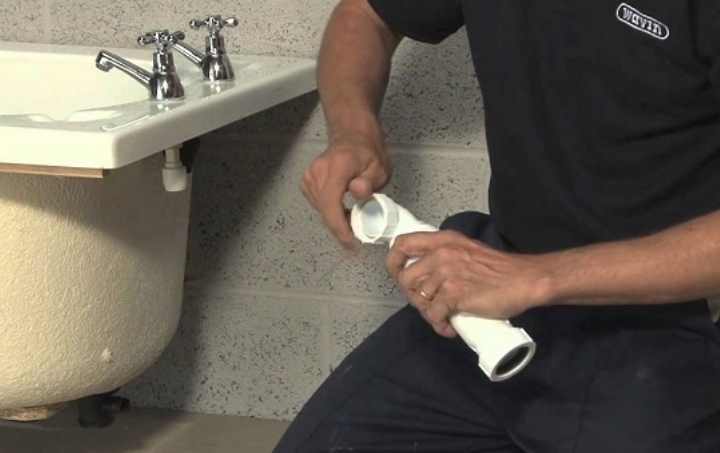
the diaphragm seal is closed with an elastic diaphragm immediately after the water is drained.- the pendulum shutter closes even if no liquid flows into the interior of the device.
- the float valve closes if water completely leaves the drain pipe, the principle of operation is similar to the operation of the fittings inside the toilet cistern.
Float mechanisms are used for sewerage in baths.
Attention! The float valve has a simple operating principle. While the water is in the drain, the float is on the surface; after the liquid leaves, the float descends to the bottom, closing the hole.
Advantages and disadvantages of corrugated hydraulic valves
The corrugated siphon type is presented by a polypropylene modification, which is distinguished by its strength, flexibility and the possibility of installation when arranging sewage systems in small-sized rooms. Due to its plasticity, such a pipe can be located in places where other types of siphon cannot be placed. This is the simplest option, which contains the minimum number of elements that do not need to be assembled.
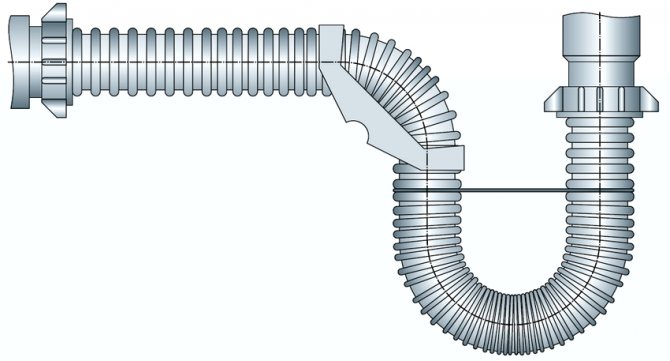

The corrugated valve is the simplest option with the fewest elements
The corrugated siphon can be turned at any angle and directed to the desired direction. This version of a do-it-yourself sewer seal is often installed under the bathroom, since the model can easily fit in a cramped place between the floor and the bottom of the tank. One end of the water seal is connected to the drain hole, and the other to the sewer pipe. With the help of a corrugation, you can also organize a drain with a water seal in the bathhouse of a private house.
Despite the many advantages, the corrugated siphon has a single, but significant drawback. The surface of the pipe has ribbed walls on which debris such as hair, soap, sand and other dirt accumulates. When installing such a siphon, a fine mesh filter should be installed.
Important! If the bellows are not cleaned for a long time, they may lose their strength and elasticity under the influence of excess weight in the form of dirt.
When operating a corrugated water seal, its condition should be monitored. Sagging causes debris to build up. The folds will start to wear out quickly, crack and leak water.
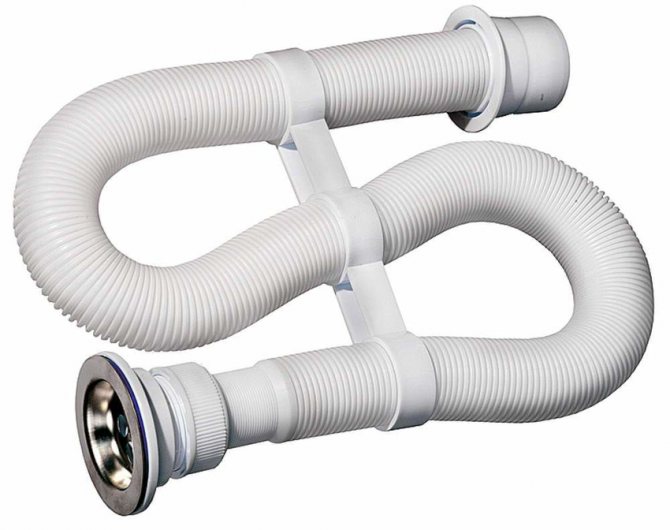

If the corrugated odor trap is not cleaned, it may lose its elasticity and strength.
Characteristics of the overflow system
Another type of product is a hydraulic siphon with a water seal for a sink or sink, equipped with an overflow system. The device is equipped with an additional pipe, which eliminates the likelihood of flooding the apartment if it is impossible to drain water into the sewer. This branch pipe is inserted into a specially created hole for it, which is located at the top of the sink or sink.
This siphon prevents flooding, but increases water consumption. If the tap is turned on and the drain is closed, when a certain level is reached, water will flow through the overflow pipe into the sewer. The odor trap with overflow system can be installed in the kitchen or bathroom.
Hydraulic valves with an overflow system are made of plastic or metal. Plastic products have a lower cost and are highly elastic. Brass-bronze siphons are characterized by strength, durability, installation complexity and high cost.
Important! When choosing a siphon with an overflow, you should pay attention to the throughput of the pipe so that the device will work efficiently in the future.
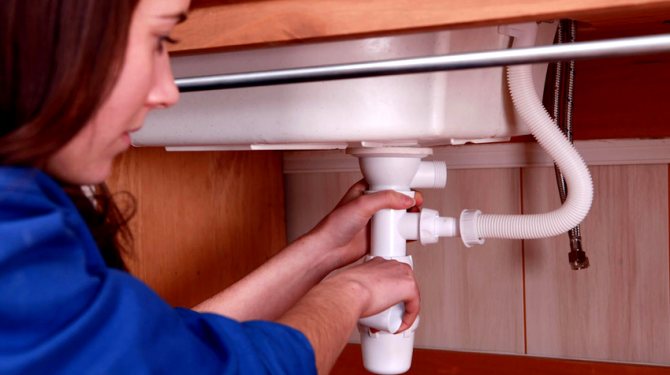

The odor trap for the sink or sink is equipped with an overflow system - an additional pipe, thanks to which the likelihood of flooding the apartment is eliminated
What is a dry siphon for sewage
The principle of operation and design of a dry water seal for sewerage differ from previous analogues. A non-return valve is installed in the threaded drain pipe, which prevents the return flow of water and the entry of unpleasant odors from the sewer system into the room.
Important! It is advisable to install such water locks exclusively in shower stalls, and in kitchen sinks, they can cause permanent blockages.
The dry odor trap for the shower stall is presented in several varieties. In the membrane version, the opening is closed at the moment of the outflow of the liquid by means of an elastic silicone membrane in the form of a short sleeve. Pendulum siphons, thanks to the curtains, provide quick blocking of access to the hole.
Float models work on the principle of a cistern. The design is an inverted lightweight glass with the edges immersed in water. A lightweight float is positioned on the surface of the water. After draining it, going down, it blocks the drain. In some models, instead of a float, a light ball is installed, which, after the liquid has flowed out, falls into the outer seat, ensuring a tight closure of the drain hole. This option can be made independently when arranging sewer wiring in a bath.
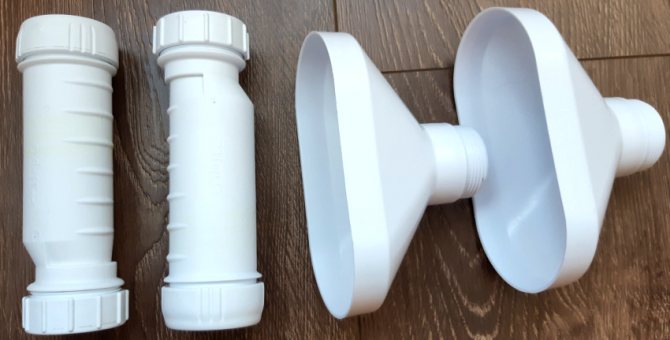

It is advisable to install a dry siphon for sewage only in shower cabins
Important! In the event that the sewer lines dry out during the period when they are not in use, the dry seal will prevent an unpleasant odor from entering the room.
Features of dry seal
A dry odor trap is used if the drain is rarely used and the water in this area dries up. The dry device is installed separately or in parallel with a conventional odor trap.If you create such a device yourself, you can simply put a tennis ball so that it blocks the entrance to the hole in the sewer pipe.
When dealing with the device of a dry water seal, it must be remembered that its functioning is based on the action of a membrane attached with a spring. The spring fixes the float in cases where the water has completely dried out. If the water flows constantly, then the spring will not be able to fix the float for a long time.
Therefore, it is advisable to turn to the pendulum system, the essence of which lies in the gravitational properties of materials and in ensuring the displacement of the center of gravity.
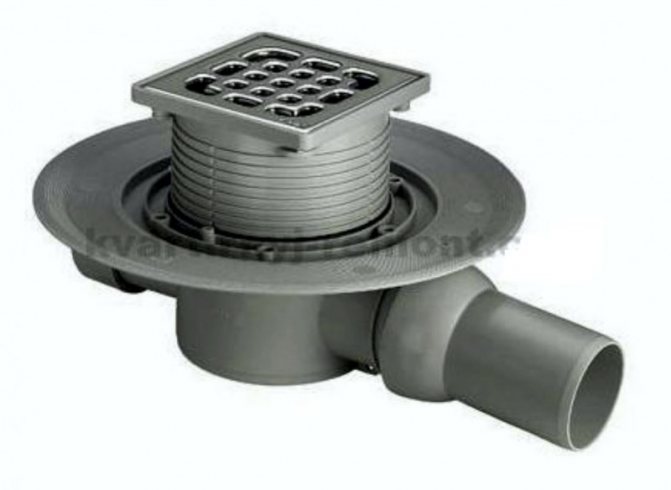

When arranging the sewer system in the bath, you can make a dry water seal yourself. To do this, find a ball, the diameter of which is slightly larger than the diameter of the sewer pipe. At the entrance to the sewer pipe, they equip a camera, and the ball is placed on the inlet. If there is no water, the ball lies on the hole, closing the passage, excluding the outflow of gases from the system. If the chamber is filled with water, the ball floats up, and the water flows unhindered into the sewer pipe.
This method is suitable not only for arranging sewerage in baths, which are operated exclusively in the warm season. If in cold weather the ball freezes to surfaces, it is easy to thaw it by pouring boiling water into the drain.
Characteristic features of a sewer drain with a water seal
When draining is carried out from the entire surface of the floor, a sewer drain with a water seal is installed. It is installed in the central part of the floor with a slight slope at the time of construction of the shower stall.
The shower drain with a water seal consists of a receiving funnel, a siphon with a removable grill and a drain with a coupling. The first element is designed to receive water and discharge it into the sewer. It is securely attached to the floor surface.
The tightness of the connection is ensured by means of a waterproofing membrane. Further, the water enters the siphon, which is represented by a small-volume chamber, passing through the upper filter grate and the branch pipe. Then the drain, overflowing through the outlet openings or the edges of the container, moves along the outlet pipe connected to the sewer pipe.
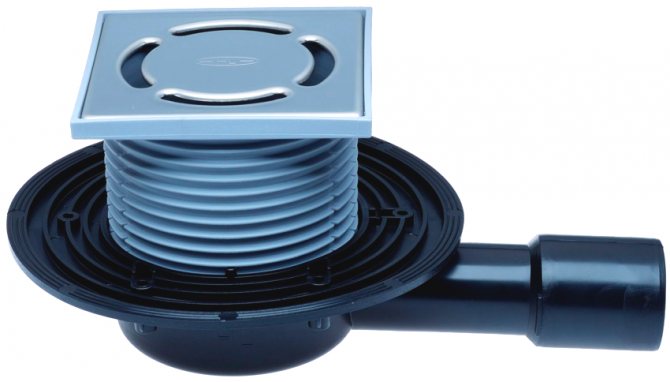

The sewer drain with a water seal consists of a siphon with a removable grate, a receiving funnel and a drain
In terms of design, such a mechanism resembles a bottle-type device. However, the shower tray siphon with odor trap does not have a removable bottom cover, which is used to remove debris. This is due to the fact that the siphon body is hidden in the floor screed. All debris is collected in the inner glass, which can be easily removed from the housing and cleaned with detergent.
Construction and material for the manufacture of a shower drain with a water seal
Sewer drains can be made of plastic or metal. Polymer odor trays for a shower in the floor do not corrode, are easy to install, are characterized by durability and low cost. Metal products can be made of cast iron or steel. The first option is characterized by high throughput and durability. However, due to its significant weight, it is laborious to install. Cast iron drains are suitable for swimming pools, toilets and laboratory rooms.
Stainless steel drains are lightweight, reliable, durable and easy to install. It is customary to install them in medical and research organizations, because the devices meet the requirements of sanitary standards. The receiving lattice can be in the form of a circle, square or rectangle.
The sewer drain with a dry odor trap has a horizontal or vertical design. The first option, the height of which is 6-10 cm, is often used for an apartment or a private house.It is also installed in confined spaces.


Float models of sewer drains with a dry water seal work on the principle of a cistern
The vertical drain has a height of 15-18 cm, is characterized by a high flow capacity and is mainly used for shower stalls. A ladder with a drainage system with a diameter of 50 mm is installed in apartments and houses, and in public premises - a water seal for sewage 110 mm.
Views
The structure for creating a water seal is called a siphon, it can have a different design. Most often, they are used:
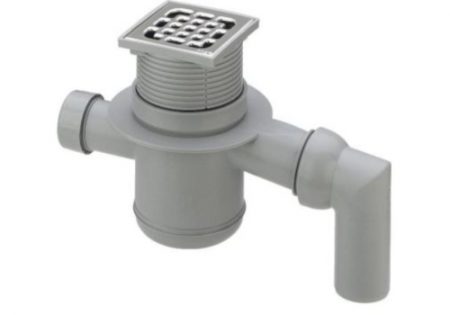

- Bottle - a universal option, suitable for any type of plumbing;
- Tubular - smooth or corrugated, used for kitchen sinks and washbasins;
- Ladders are a special type of siphon used in shower cabins, as well as in washing rooms of baths.
In addition, there are dry siphons, in which a membrane is used instead of a water plug, which acts as a check valve. Such a shutter is good in that it will restrain the movement of not only gases, but also liquids.
The use of such equipment is especially recommended in apartments located on the lower floors of multi-storey buildings. It will prevent the outflow of drains coming from the upper apartments through the plumbing when a blockage forms in the sewer pipe. We will figure out what types of siphons exist and what features of installing this element of the sewage system with our own hands exist.
Bottle
The bottle siphon is often used to assemble sewer systems. The device has a specific shape, the device consists of a sump and a flask. At the bottom of the siphon, there is always water, which creates a water seal.
Advice! Previously, in almost every apartment, bottle siphons made of cast iron were installed, now they have been replaced with analogues made of polymer materials. Brass sewerage system elements are extremely rare.
A unified bottle-type siphon can be used to connect two drains at the same time. This version has a curved pipe that is connected to a tee with connected taps from the plumbing elements.
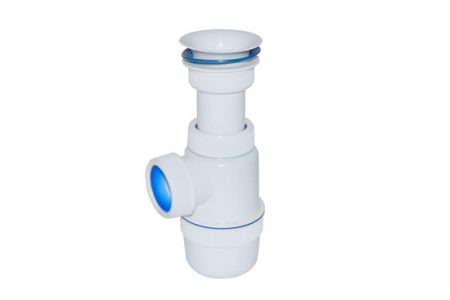

You need to choose a siphon taking into account its throughput. The more elements you plan to connect to the siphon, the more efficient the model should be. The main advantage of this model is that it can be easily cleaned without disconnecting the siphon from the sink.
The presence of a siphon in the siphon allows you to save valuable things (for example, jewelry), which by mistake can enter the sewer system. In addition, the bottle-type siphon has a rigid structure, so it will last longer than corrugated pipe models.
Tubular
The siphon is made of smooth or corrugated pipes, which are bent so that a kind of "loop" is formed, located below the main pipe in level. This "loop" will contain the water plug.
Smooth tubular siphons are rarely used, since an ordinary pipe is difficult to bend, in addition, such a model takes up a lot of space. Therefore, in most cases, a corrugated pipe is used to make a siphon. The corrugated pipe is easy to bend in the desired direction, the finished siphon takes up a minimum of space. This option has the following advantages:
- easy to assemble by yourself;
- the model has a universal purpose, it can be installed with any plumbing element, including a toilet. In the latter case, a corrugated pipe with a diameter of 110 mm is used;
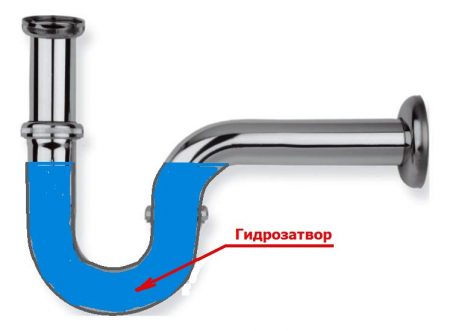

- if necessary, you can easily adjust the length of the siphon loop, even if the system is already installed and connected;
- the sink can be removed and moved (over short distances) without disconnecting the siphon from it.
Ladder
Compared to a conventional siphon, the drain has a more complex design. This element is installed in the shower tray or directly in the floor covering. A full range of works on the installation of the ladder
- connecting the ladder to the sewerage outlet;
- performance of heat and waterproofing;
- production of a concrete screed with a slope towards the ladder;
- laying a moisture-resistant coating.
Advice! Most often, ceramic tiles are used as a moisture-resistant coating. This material is not afraid of contact with water, it is easy to keep it clean.
If an ordinary siphon should provide only water drainage, then the ladder performs additional functions:
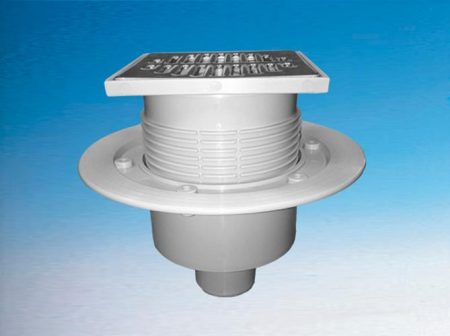

- ensures the tightness of the connection to the floor;
- provides preliminary filtration, preventing large contaminants from entering the pipe.
In addition, the drain, like a regular siphon, creates a water seal, which prevents the penetration of an unpleasant odor into the room.
How to choose the right water seal for the sewage system
When choosing a water seal for the sewage system, the price of which is in the range of 300-600 rubles, the following factors should be taken into account:
- dimensions of the assembled siphon;
- features of this type of device;
- material for the manufacture of pipes and fasteners;
- number of drains and possible additional connections;
- the level of protection against blockages;
- the presence or absence of overflow.
The shutter type is selected based on the installation location. For the kitchen sink, the best solution would be a bottle design equipped with a container for collecting food waste. For a bath, it is most convenient to mount a corrugated siphon, which can be located even in the most cramped conditions.
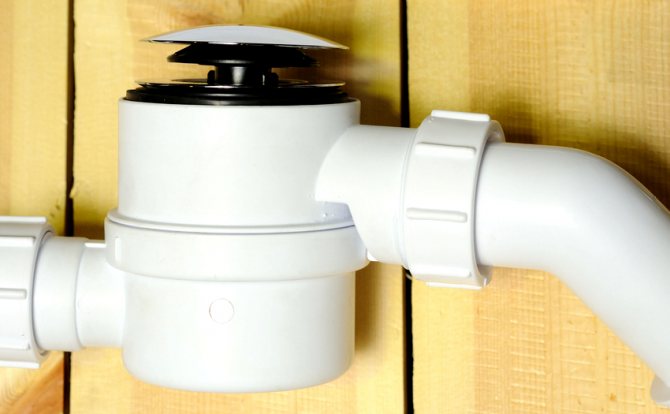

If the shower siphon will be used infrequently, it is recommended to install a dry odor trap.
The version of the shower siphon is selected taking into account the frequency of its use. If it will be used rarely, a dry odor seal for a bath or shower should be installed, which, even when the water dries, will not let foreign odors into the room.
The number of inlets in the siphon must correspond to the number of drains for which this odor trap is intended. An important criterion is the diameter of the throat of the device. For the sink and washbasin, it can be the smallest, and for the toilet - the largest. The diameter of the outlet pipe is also taken into account when connected to a sewer pipe. For sinks and washbasins, a 50 mm water seal is sufficient. For a toilet bowl, this parameter should be at least 100 mm.
Material for the manufacture of a hydraulic seal
The reliability and durability of the device depend on the material of manufacture. Traditionally, steam locks for baths, bathrooms and kitchens were made of cast iron, due to which they were characterized by strength, resistance to aggressive environments and a long service life. The disadvantages of products include the presence of an internal rough surface, which tends to retain various contaminants. It is ideal for industrial construction.
Most modern models of hydraulic locks are made of polypropylene, as a result of which they have a low cost. The devices are characterized by strength, reliability, chemical inertness, lack of tendency to accumulate contaminants in the cavity (due to the smooth inner surface).
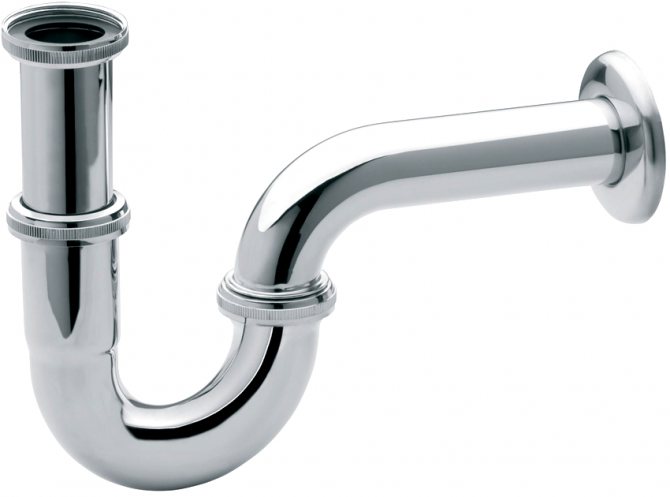

Premium siphons are available in brass or bronze and nickel plated
Premium dry odor traps are made of brass or bronze with a nickel plated finish, which gives the products an aesthetic appearance. Such valves are characterized by a long period of reliable operation. Stainless steel siphons are in demand in hospitals and children's institutions. Such devices are well cleaned and disinfected, which does not affect their durability.
Installation of a water seal
- If you want to installation of a siphon with one drain, the presence of one grate is allowed, fixed with a lower nut adjacent to the drain.
- In the variant with two outputs, you will need to install a plumbing piece with the appropriate parameters.
- If you need to connect household appliances with a drain system, there is a need in a siphon with an extra outlet.
- The bath will require the presence of a tee, to which the overflow pipe will adjoin. When the water reaches the hole, it will come out through the upper drain, and thus protect against flooding.
Connecting a water seal requires specific conditions:
- sinks and a bathroom are connected via an autonomous 50 mm siphon;
- simultaneous connection of two sinks to one water shut-off system is prohibited;
- remember about sealing ring (1.5 cm) at the edge of the branch pipe. It is necessary to align the joints of the pipe and socket circles;
- gaps and crevices are masked with a sealant.
Diy installation sequence of a water seal for sewage
Installing a water seal for a sewage system in a bath, bathroom or kitchen is a simple undertaking that you can do yourself without having certain skills. Under the washbasin or sink, the installation process is quite simple, and under the bathroom it is more laborious, due to the inconvenient location of the drain system.
Important! Any type of siphon can be purchased complete with all the components at a plumbing store.
Consider installing a do-it-yourself water seal for a 110 mm bottle-type sewage system. The set includes a siphon, a corrugated pipe, overflow design elements and fasteners. The first step is to equip an overflow hole. For this, an elastic gasket is inserted into it, which is fixed with a silicone sealant. Then a chrome-plated decorative element with a rod is screwed on, on which a lamb is attached.
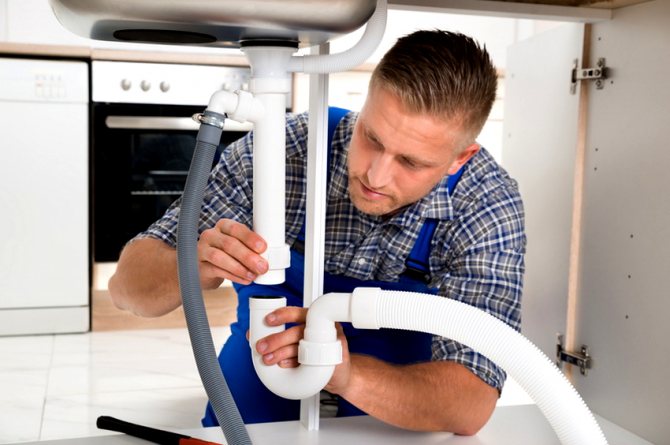

After installing the water seal, you must remember to connect it to the sewer pipe
At the next stage, fittings are installed to decorate the drain hole in the bathtub, sink or washbasin. A long fixing screw is screwed into it, which fixes the siphon. First, it is twisted by hand, then clamped with a key. A rubber gasket is put on the plastic outlet. Next, insert the knee bolt. Finally, tighten the plastic outer nut. The odor trap is connected to the sewer pipe by means of a polypropylene pipe.
After the installation is complete, the system is tested. For this, the device is filled with water. All elements of the system are inspected for leaks.
Double-turn
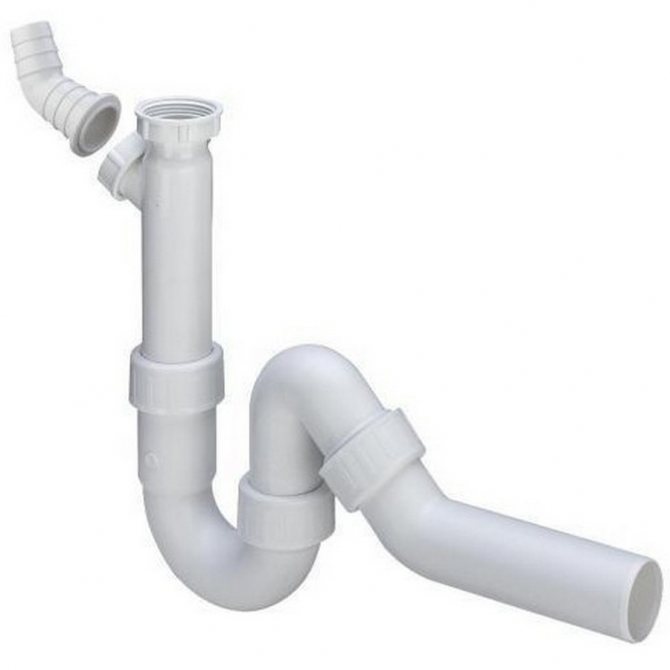

According to the principle of action and form, such sewer water locks resemble knees, but differ from them in that they have not 1, but 2 bends. The pipes from which they are folded are specially shaped to avoid blockages while still withstanding extreme pressure and shock loads. Such properties made it possible to widely use double-turn siphons in industrial enterprises, where it is important to remove large volumes of water continuously. The design is also perfectly leak-proof. It is adjustable, which allows you to install it in any, even very narrow places.
Bottle siphons are easier to maintain than double-turn ones, but it is the latter that give a high degree of reliability in operation, which in some cases is indispensable.
Corrugated
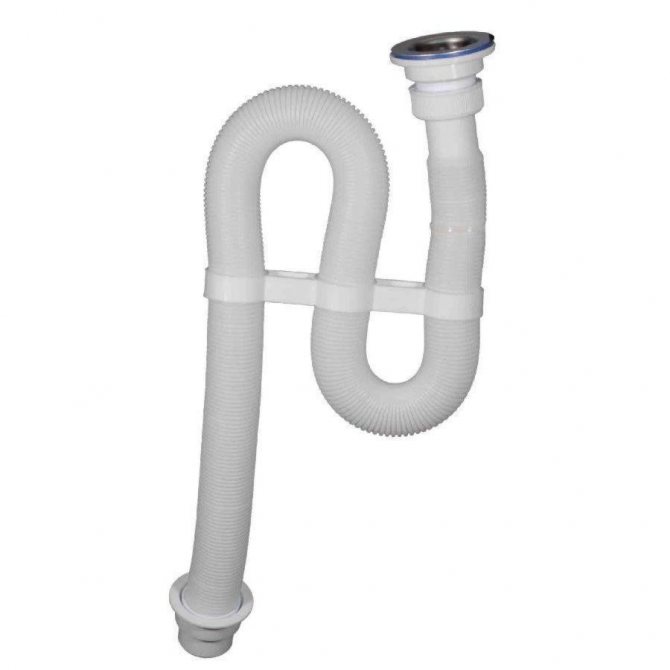

They are polypropylene pipes with flexible folded structure. At one end, a siphon of this type is attached to the drain of the plumbing fixture, the other to the entrance to the sewer. Between these points, the tube itself can be bent and positioned in a large number of options, which makes corrugated water locks the only applicable in small apartments.
By placing the device as required by the space under the bathroom, the sink, you can equip even the most modest room in terms of area. Siphon of this type is easy to install. Of the minuses - relatively quick wear and tear and blockage. They arise due to the fact that hard particles accumulate on a folded surface faster than on a smooth surface - hair, food, bits of soap, etc. If the owners notice a sagging tube, it should be replaced as soon as possible.
Overflow siphons
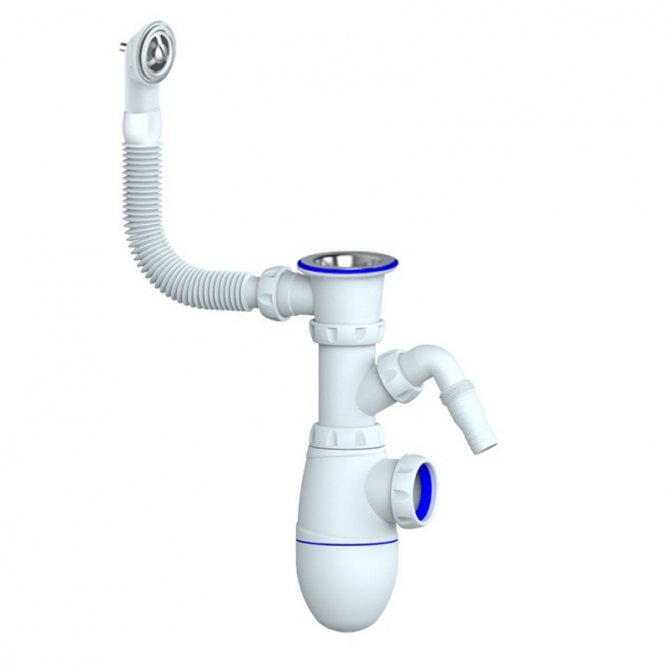

This is a separate type of hydraulic seals for sewage, providing for an additional drain hole in the plumbing. They do it in order to prevent water from pouring out of the bathtub, sinks on the floor, if for some reason it suddenly stopped coming out into the main drain hole. When using a siphon with an overflow, its main pipe is mounted as usual, and the additional pipe is connected to the overflow hole.
This type of odor trap is popular for its safety. However, they also have a drawback. This is the likelihood of spilling excess water while taking a bath or washing. The owner may incur additional financial costs for utility bills.
If you are going to install a siphon with an overflow, it is worth choosing a model correctly. Those with enough space can afford the most reliable metal siphon. And those with little space in their homes will benefit from the purchase of compact and flexible plastic models.
Another important nuance is the choice of overflow according to its throughput. If it turns out to be too small than the amount of water in the bath requires, then the consequences of using such a siphon can even be dangerous. Data on the technical parameters of each siphon should be immediately recognized when examining it in a store. Buying the wrong part will be a waste of money.
How to mount a sewer drain with a water seal
Installing a sewer drain with a dry water seal is a very responsible and time-consuming process. The correctness of the work performance directly determines the level of its high-quality and durable operation.
At the first stage, the floor in the shower or bath room is lifted, which should have a slight slope towards the ladder, which will contribute to the spontaneous drainage of water from the horizontal surface.
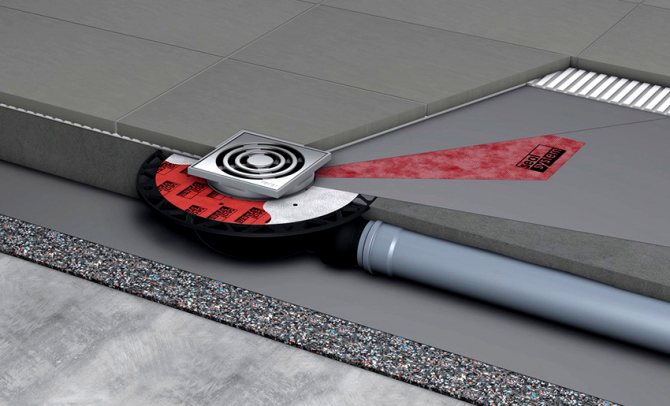

The sewer drain is installed according to the instructions - thermal insulation, waterproofing, cement screed and floor tiles are laid on the floor
The sewer drain is installed according to the instructions that come with the device. Heat-insulating material is laid on the surface of the floor, at the same time acting as sound insulation, which contributes to the quiet drainage of water from the plumbing fixture into the sewer system. Styrofoam is suitable for this. Then a layer of waterproofing is laid. To do this, you can use a roll material with a membrane structure or a coating mixture.
Next, a cement screed is made, the thickness of which is selected taking into account the height of the ladder and the thickness of the tile. Floor tiles are laid on top with an adhesive solution.
Important! The water seal grill must be flush with the tiles.
Hydraulic seal structure
By its structure, the sewer water seal is a siphon filled with water. Each type of plumbing has its own varieties:
- tubular (for kitchen sinks);
- corrugated (for washbasins in bathrooms);
- ladders (for baths, showers, saunas);
- bottle (for all types of plumbing);
- double-turn (for equipment requiring high reliability);
- special for exclusive baths (made for certain types of baths).
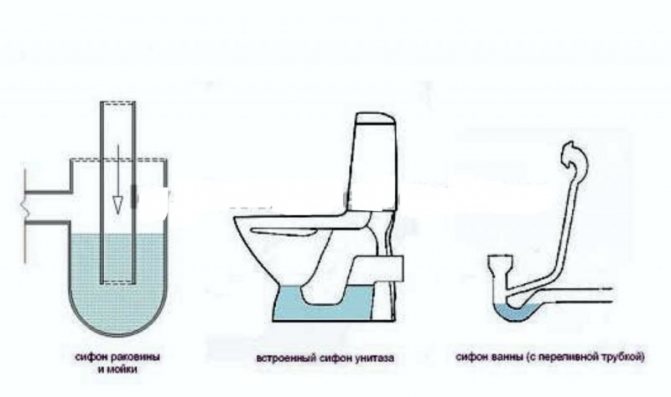

Each odor trap needs to be individually adjusted, otherwise the siphon can be ripped off after the tank is completely flushed.This cannot happen with dry seals for baths, because the role of water in such a device is played by a ball that blocks the entrance to the sewer pipe. In this case, it is impractical to use a water siphon, because such a drain is used quite rarely, so the water in the siphon will dry out sooner or later.
Toilet locks have their own characteristics. They are divided into 2 types: S-siphons (water moves down to the floor) and P-siphons (the drain is located behind the toilet bowl).
Possible reasons for the violation of the correct operation of the water seal
The hydraulic valve is a simple product in terms of design, which consists of a minimum number of uncomplicated elements. Therefore, the failure of the siphon is extremely rare. In this case, situations may arise that negatively affect its normal functioning.
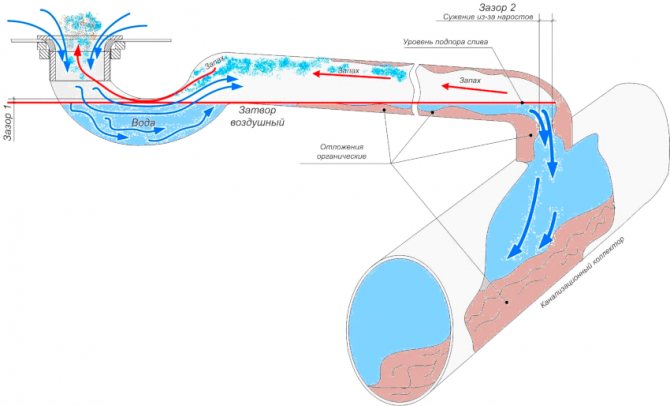

Failure to comply with slopes and a violation of the sequence of assembly of the hydraulic seal can negatively affect its operation.
A device malfunction can occur as a result of a sharp drop in pressure in the pipes, malfunction of the sewer network, depressurization of drain pipes, which is possible as a result of mechanical damage or improper connection.
If a riser is clogged in a multi-storey building on the upper floors, when large volumes of water are drained, a vacuum is formed in the pipe, as a result of which water is attracted from the water seal. This causes unpleasant odors to appear. In this case, the question arises of how to eliminate the airlock in the sewer. You can eliminate the problem by cleaning the riser or installing a vacuum valve at its end. Dry valves often begin to malfunction as a result of clogging of the descending float or closing diaphragm.
Incorrect installation will also negatively affect the operation of the device. The reason may lie in non-observance of slopes, violation of the sequence of assembly of system elements, spontaneous straightening of the corrugation.
Important! If the siphon is rather old, it may no longer cope with its main function of protecting the room from the penetration of unpleasant odors. In this case, you will need to disinfect the well with a water seal or replace the device with a new element.
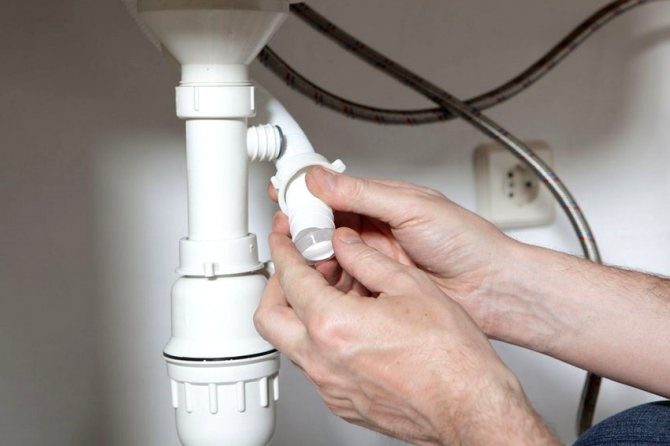

If the siphon is old, it may not cope with its task, it is necessary to replace the water seal with a new one
If there is a sewage odor in the room, it is necessary to check the functionality of the water seal. You should pay attention to the water level in the toilet, which should be the same for every flush. In the bathroom and kitchen, the check can be done with a flame. For this, a match is brought as close to the sink as possible. The absence of a flame will indicate normal operation of the device.
If the flame ripples, you should turn on the water for a minute, and then check the operation of the device again with a flame. If it still wobbles, the siphon is faulty.
Indispensability of a water seal in winemaking
What is a water seal for? During the fermentation process, a large amount of carbon dioxide is released (about 4 m3 / 1 liter of the obtained alcohol). If carbon dioxide accumulates in the container, a very high pressure will be created. And sooner or later there will be an explosion
Therefore, it is important to remove the gas from the inside, but in no case should oxygen be introduced into the container. Indeed, in this case, bacteria will multiply, which convert alcohol into acetic acid.
And while oxygen does not penetrate into the fermentation chamber, the bacteria are in a dormant state.
.
In fact, this valve is a special valve that removes carbon dioxide to the outside and prevents oxygen from entering. Without it, it is impossible to make wine, since the result will be vinegar. Experienced winemakers and moonshiners have fiercely debated the need to use it.But if you are new to this business, then you cannot do without it.
If we talk about home brew, then there is no unequivocal answer to the need for a water seal. But with such a design, the mash can be kept for longer without distillation, and it will not oxidize. And absolutely all alcohol will be safe.
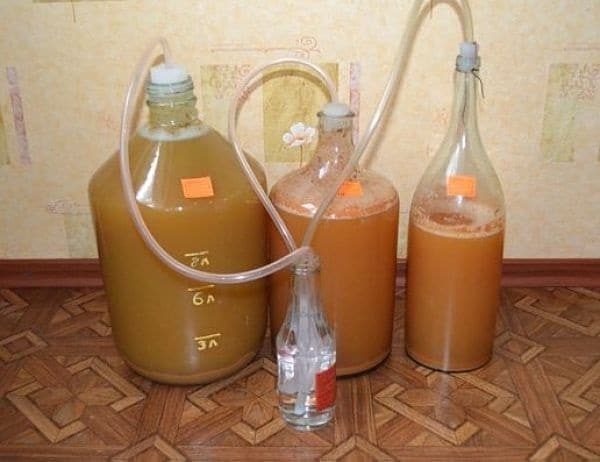

Water seal on the mash

